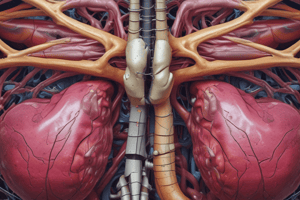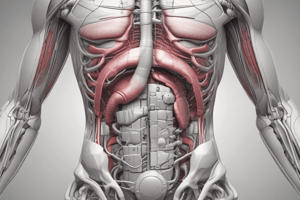Podcast
Questions and Answers
Which muscle of the posterior abdominal wall has attachments to the transverse processes of lumbar vertebrae and sides of the bodies of T12–S1 vertebrae?
Which muscle of the posterior abdominal wall has attachments to the transverse processes of lumbar vertebrae and sides of the bodies of T12–S1 vertebrae?
- Quadratus lumborum
- Rectus abdominis
- Iliacus
- Psoas major (correct)
Which muscle of the posterior abdominal wall acts with the iliacus to flex the thigh and stabilize the hip joint?
Which muscle of the posterior abdominal wall acts with the iliacus to flex the thigh and stabilize the hip joint?
- Psoas major
- Iliacus (correct)
- Quadratus lumborum
- Transversus abdominis
Which muscle of the posterior abdominal wall has attachments to the medial half of the inferior border of the 12th rib and tips of lumbar transverse processes?
Which muscle of the posterior abdominal wall has attachments to the medial half of the inferior border of the 12th rib and tips of lumbar transverse processes?
- Iliacus
- Quadratus lumborum (correct)
- Psoas major
- Internal oblique
Which muscle of the posterior abdominal wall is innervated by the femoral nerve (L2–L4) and acts to flex the thigh and stabilize the hip joint?
Which muscle of the posterior abdominal wall is innervated by the femoral nerve (L2–L4) and acts to flex the thigh and stabilize the hip joint?
Which muscle of the posterior abdominal wall acts inferiorly with the iliacus to flex the trunk when sitting?
Which muscle of the posterior abdominal wall acts inferiorly with the iliacus to flex the trunk when sitting?
Which muscle of the posterior abdominal wall acts superiorly to flex the vertebral column laterally to balance the trunk?
Which muscle of the posterior abdominal wall acts superiorly to flex the vertebral column laterally to balance the trunk?
What type of muscle makes up the external layer of the superior third of the esophagus?
What type of muscle makes up the external layer of the superior third of the esophagus?
Where is the esophagogastric junction located?
Where is the esophagogastric junction located?
What marks the esophagogastric junction internally?
What marks the esophagogastric junction internally?
What type of muscle makes up the external layer of the inferior third of the esophagus?
What type of muscle makes up the external layer of the inferior third of the esophagus?
During its short abdominal course, is the esophagus retroperitoneal or intraperitoneal?
During its short abdominal course, is the esophagus retroperitoneal or intraperitoneal?
At what level is the esophagus located in the midline?
At what level is the esophagus located in the midline?
Where is the appendix usually supplied by arteries?
Where is the appendix usually supplied by arteries?
What is the usual position of the appendix?
What is the usual position of the appendix?
Which vessels drain the appendix?
Which vessels drain the appendix?
What is the nerve supply to the cecum and appendix derived from?
What is the nerve supply to the cecum and appendix derived from?
What procedure is used to remove the appendix via small incisions?
What procedure is used to remove the appendix via small incisions?
What is the purpose of colonoscopy?
What is the purpose of colonoscopy?
Which artery primarily supplies the abdominal part of the esophagus?
Which artery primarily supplies the abdominal part of the esophagus?
What is the chief function of the stomach?
What is the chief function of the stomach?
Which nerve provides parasympathetic innervation to the stomach?
Which nerve provides parasympathetic innervation to the stomach?
Where does the cecum act as a site for the fermentation of indigestible plant materials?
Where does the cecum act as a site for the fermentation of indigestible plant materials?
Which vein drains blood from the stomach to the liver?
Which vein drains blood from the stomach to the liver?
What controls the flow of material from the small intestine into the large intestine?
What controls the flow of material from the small intestine into the large intestine?
Where do efferent lymphatic vessels from lymph nodes drain into?
Where do efferent lymphatic vessels from lymph nodes drain into?
Where do superficial lymphatics from diaphragmatic and visceral surfaces of the liver drain toward?
Where do superficial lymphatics from diaphragmatic and visceral surfaces of the liver drain toward?
Where do nerves of the liver derive from?
Where do nerves of the liver derive from?
How many places are ureters normally constricted in?
How many places are ureters normally constricted in?
What is involved in the blood supply of kidneys and ureters?
What is involved in the blood supply of kidneys and ureters?
What are the components of the diaphragm?
What are the components of the diaphragm?
What type of muscle makes up the external layer of the superior third of the esophagus?
What type of muscle makes up the external layer of the superior third of the esophagus?
Where is the esophagogastric junction located in relation to the midline?
Where is the esophagogastric junction located in relation to the midline?
What marks the esophagogastric junction internally?
What marks the esophagogastric junction internally?
What type of muscle makes up the external layer of the inferior third of the esophagus?
What type of muscle makes up the external layer of the inferior third of the esophagus?
During its short abdominal course, is the esophagus retroperitoneal or intraperitoneal?
During its short abdominal course, is the esophagus retroperitoneal or intraperitoneal?
What is the composition of the middle third of the esophagus in terms of muscle types?
What is the composition of the middle third of the esophagus in terms of muscle types?
Which muscle of the posterior abdominal wall acts inferiorly with iliacus to flex the trunk when sitting?
Which muscle of the posterior abdominal wall acts inferiorly with iliacus to flex the trunk when sitting?
Which muscle of the posterior abdominal wall has attachments to the transverse processes of lumbar vertebrae and sides of the bodies of T12–S1 vertebrae?
Which muscle of the posterior abdominal wall has attachments to the transverse processes of lumbar vertebrae and sides of the bodies of T12–S1 vertebrae?
Which muscle of the posterior abdominal wall is innervated by the femoral nerve (L2–L4) and acts to flex the thigh and stabilize the hip joint?
Which muscle of the posterior abdominal wall is innervated by the femoral nerve (L2–L4) and acts to flex the thigh and stabilize the hip joint?
Which muscle of the posterior abdominal wall acts with the iliacus to flex the thigh and stabilize the hip joint?
Which muscle of the posterior abdominal wall acts with the iliacus to flex the thigh and stabilize the hip joint?
Which muscle of the posterior abdominal wall acts superiorly to flex the vertebral column laterally to balance the trunk?
Which muscle of the posterior abdominal wall acts superiorly to flex the vertebral column laterally to balance the trunk?
Which muscle of the posterior abdominal wall acts inferiorly with iliacus to flex the thigh and stabilize the hip joint?
Which muscle of the posterior abdominal wall acts inferiorly with iliacus to flex the thigh and stabilize the hip joint?
Where does the stomach receive its arterial supply from?
Where does the stomach receive its arterial supply from?
What forms the longer convex border of the stomach?
What forms the longer convex border of the stomach?
Where is the cecum located?
Where is the cecum located?
Which vessels drain blood rich in nutrients from the stomach to the liver?
Which vessels drain blood rich in nutrients from the stomach to the liver?
What innervates the esophagus and stomach?
What innervates the esophagus and stomach?
What is the chief function of the stomach?
What is the chief function of the stomach?
Which artery supplies the cecum?
Which artery supplies the cecum?
What is the nerve supply to the cecum and appendix derived from?
What is the nerve supply to the cecum and appendix derived from?
What is the usual position of the vermiform appendix?
What is the usual position of the vermiform appendix?
Which procedure is used to observe and photograph the interior surface of the colon?
Which procedure is used to observe and photograph the interior surface of the colon?
Where is the spleen located intraperitoneally?
Where is the spleen located intraperitoneally?
What are the components of the liver?
What are the components of the liver?
Where do efferent lymphatic vessels from lymph nodes drain into?
Where do efferent lymphatic vessels from lymph nodes drain into?
From where do the nerves of the liver derive?
From where do the nerves of the liver derive?
What are the potential sites of obstruction by ureteric (kidney) stones?
What are the potential sites of obstruction by ureteric (kidney) stones?
Where do the superficial lymphatics from the liver drain towards?
Where do the superficial lymphatics from the liver drain towards?
What marks the esophagogastric junction internally?
What marks the esophagogastric junction internally?
What type of muscle makes up the external layer of the inferior third of the esophagus?
What type of muscle makes up the external layer of the inferior third of the esophagus?
Where do efferent lymphatic vessels from lymph nodes drain into?
Where do efferent lymphatic vessels from lymph nodes drain into?
From where do the superficial lymphatics from the liver drain?
From where do the superficial lymphatics from the liver drain?
Where do nerves of the liver derive from?
Where do nerves of the liver derive from?
How many normal constrictions do ureters have?
How many normal constrictions do ureters have?
What is the blood supply of kidneys and ureters provided by?
What is the blood supply of kidneys and ureters provided by?
Where do the peri-arterial extensions of the sympathetic and parasympathetic nerve plexuses deliver fibers to?
Where do the peri-arterial extensions of the sympathetic and parasympathetic nerve plexuses deliver fibers to?
Flashcards are hidden until you start studying
Study Notes
Anatomy and Physiology of the Liver, Kidneys, and Diaphragm
- Efferent lymphatic vessels from lymph nodes drain into celiac lymph nodes, then cisterna chyli at the inferior end of the thoracic duct
- Superficial lymphatics from diaphragmatic and visceral surfaces of the liver drain toward the bare area of the liver, then to phrenic lymph nodes or join deep lymphatics that accompany hepatic veins
- Nerves of the liver derive from the hepatic nerve plexus, consisting of sympathetic fibers from the celiac plexus and parasympathetic fibers from the anterior and posterior vagal trunks
- Ureters are normally constricted in three places, potential sites of obstruction by ureteric stones
- Blood supply of kidneys and ureters involves renal segments and segmental arteries
- The internal structure of the kidney and suprarenal gland can be visualized
- The diaphragm consists of sternal, costal, and lumbar parts, as well as crura and diaphragmatic apertures
- Efferent vessels from posterior mediastinal lymph nodes join the right lymphatic and thoracic ducts
- Some lymphatic vessels drain to the left gastric nodes, parasternal lymph nodes, and lymphatics of the anterior abdominal wall
- The hepatic plexus accompanies branches of the hepatic artery and hepatic portal vein to the liver
- Autonomic nerves of the posterior abdominal wall include pre- and postsynaptic sympathetic and parasympathetic fibers, with intrinsic parasympathetic ganglia occurring in the abdominal viscera
- Diaphragmatic apertures permit structures to pass between the thorax and abdomen, including the IVC, esophagus, and aorta
Anatomy and Surgical Procedures of the Appendix, Colon, Spleen, and Liver
- The ileum enters the cecum obliquely and forms the ileal orifice, which partly invaginates into it.
- The vermiform appendix is a blind intestinal diverticulum extending from the posteromedial aspect of the cecum, usually retrocecal.
- The cecum is supplied by the ileocolic artery, while the appendix is supplied by the appendicular artery, both draining into the ileocolic vein.
- Lymphatic vessels from the cecum and appendix pass to lymph nodes in the meso-appendix and to the ileocolic lymph nodes.
- The nerve supply to the cecum and appendix derives from sympathetic and parasympathetic nerves from the superior mesenteric plexus.
- Laparoscopic appendectomy is a standard procedure performed through small incisions; a transverse or gridiron incision may be used in some cases.
- Colectomy is performed for chronic colon inflammation, with ileostomy established for the removal of the terminal ileum and colon.
- Colonoscopy and sigmoidoscopy are procedures used to observe and photograph the interior surface of the colon.
- The spleen is a mobile ovoid lymphatic organ located intraperitoneally in the left upper quadrant, typically about 12 cm long and 7 cm wide.
- The liver is composed of right and left lobes, with consistent secondary and tertiary branches of the hepatic portal vein and hepatic artery forming hepatic segments.
- The liver is a major lymph-producing organ, with lymphatic vessels occurring as superficial and deep lymphatics in the subperitoneal fibrous capsule and connective tissue.
- Superficial and deep lymphatic vessels from the liver drain to the hepatic lymph nodes scattered along the hepatic vessels and ducts in the lesser omentum.
Lymphatic Drainage and Innervation of Abdominal Organs
- Efferent lymphatic vessels from lymph nodes drain into celiac lymph nodes, which then drain into the cisterna chyli at the inferior end of the thoracic duct.
- Superficial lymphatics from the liver drain towards the bare area of the liver, joining deep lymphatics that accompany the hepatic veins and drain into the posterior mediastinal lymph nodes.
- Nerves of the liver derive from the hepatic nerve plexus, consisting of sympathetic fibers from the celiac plexus and parasympathetic fibers from the anterior and posterior vagal trunks.
- Ureters are normally constricted in three places, which are potential sites of obstruction by ureteric (kidney) stones.
- The blood supply of kidneys and ureters is provided by the superior and inferior arteries, with the ureters normally constricted at specific sites.
- The internal structure of the kidney and suprarenal gland is illustrated, showing the anatomical details.
- Normal constrictions of ureters are demonstrated by retrograde pyelogram, depicting the sites where relative constrictions in the ureters normally appear.
- The peri-arterial extensions of the sympathetic and parasympathetic nerve plexuses deliver fibers to the abdominal viscera, where intrinsic parasympathetic ganglia occur.
- The diaphragm has sternal, costal, and lumbar parts, with muscular crura arising from the bodies of the superior three lumbar vertebrae and attaching to the central tendon.
- The diaphragm is attached to the medial and lateral arcuate ligaments, which are thickenings of the fascia covering the psoas and quadratus lumborum muscles.
- Diaphragmatic apertures permit structures to pass between the thorax and the abdomen, including the IVC, esophagus, and aorta.
- The central tendon of the diaphragm is fused with the inferior surface of the fibrous pericardium, and the surrounding muscular part forms a continuous sheet, divided into sternal, costal, and lumbar parts.
Studying That Suits You
Use AI to generate personalized quizzes and flashcards to suit your learning preferences.




